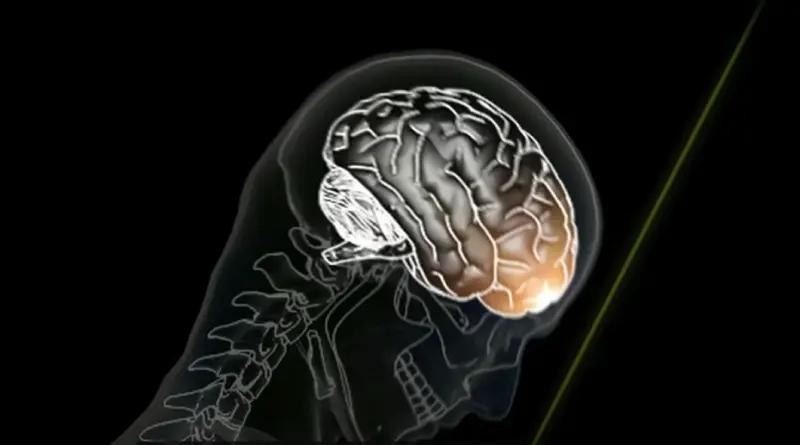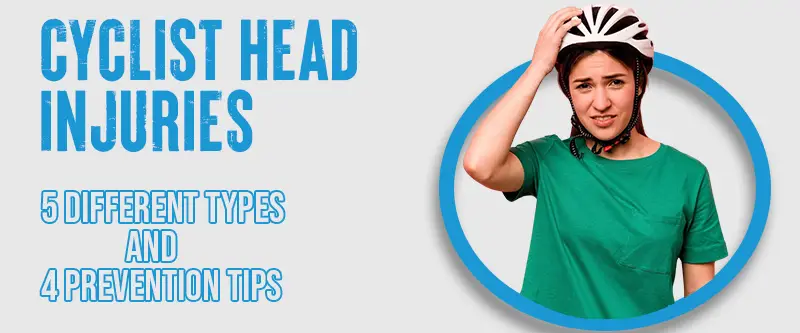Injury to the head causes disability and death among adults. You can suffer from mild head injuries such as bumps, bruises, or cuts or more severe injuries such as concussions, deep cuts, open wounds, fractured skull bones, or internal bleeding.
Bicyclists are most likely to suffer head injuries, which account for one-third of emergency room visits, two-thirds of hospitalizations, and three-fourths of deaths. It is estimated that cyclists sustain facial injuries at a rate nearly equal to that of cyclists who sustain head injuries.
We will discuss different types and causes of cyclist head injuries, the importance of promoting safety measures, and prevention strategies to protect the heads of all cyclists.
Cyclist Head Injuries: 6 Causes & 5 Proven Prevention Tips

Cycling accidents can lead to head injuries that include concussions and traumatic brain injuries (TBI). We will provide an in-depth discussion of cyclist head injuries of different types and severity, including their symptoms and frequency.
Concussions
An injury to the head caused by a blow or impact to the head. It is the most common type of head injury in cycling accidents. Here are some crucial facts and details about concussions:
- Concussions can cause physical, cognitive, and emotional symptoms that can last from a few days to several weeks.
- Some of the common symptoms of concussions include headache, dizziness, confusion, memory problems, and mood swings.
- Riders who have experienced one concussion are at an increased risk of sustaining subsequent concussions.
- Helmets reduce the risk of concussion.
Skull Fractures
Skull fractures occur when any of the bones of the skull break or crack. It is less common than concussions but poses a significant risk to the rider’s health. Facts and details about skull fractures:
- Skull fractures typically occur when riders hit their heads on a hard surface, such as the pavement or a car.
- Symptoms of skull fractures can include headaches, nausea, vomiting, and seizures.
- The severity of skull fractures varies according to the type and extent of the fracture.
- Wearing a helmet can help prevent or minimize the impact of skull fractures.
Traumatic Brain Injuries (TBI)
Traumatic brain injury (TBI) is a type of head injury that can damage the brain tissue and cause long-term health consequences. Here are some essential facts and details about TBIs:
- TBIs can be caused by a solid blow to the head or a forceful shaking of the head.
- A TBI can cause loss of consciousness, severe headaches, seizures, and memory loss.
- TBIs can result in long-term or permanent disabilities, including cognitive impairment, personality changes, and behavioral problems.
- TBIs are significantly reduced when a helmet is worn.
Hemorrhages & Contusions
Hemorrhages and contusions are types of head injuries that involve bleeding and bruising of the brain tissue. Detailed information on these types of damages:
- Hemorrhages and contusions can result from a substantial impact on the head.
- Symptoms of hemorrhages and contusions can include nausea, vomiting, dizziness, seizures, and loss of consciousness.
- It can be a minor injury or a life-threatening injury.
- Helmets significantly reduce hemorrhages and contusions.
Risk of Long-term Psychological & Cognitive Effects
Cyclists who sustain head injuries are at risk of experiencing lasting psychological effects, even after the physical symptoms have subsided. Facts and details about the risk of long-term outcomes:
- Concussions and TBIs are associated with an increased risk of developing depression, anxiety, and post-traumatic stress disorder (PTSD).
- TBIs can lead to long-term cognitive impairment, such as memory problems, reduced attention span, and difficulty with problem-solving.
- These long-term effects can significantly impact the cyclist’s quality of life and ability to ride a bike again.
Injury to Cyclist’s Heads: 6 Contributing Factors

Cycling is a popular mode of transportation, exercise, and leisure activity, but it also poses a significant risk of injury, especially head injuries. We will examine the various causes and contributing factors to cyclist head injuries.
Lack of Helmet Usage
The leading cause of cyclist head injuries is the lack of helmet usage. According to studies, helmets reduce head injury risk by 85%. Unfortunately, many cyclists do not wear helmets because they are uncomfortable or inconvenient or because they believe they are unnecessary. Here are some reasons why helmets are essential for cyclist safety:
- Helmets protect the brain from impact injuries, which can cause permanent damage or even death.
- Helmets absorb and redistribute the force of impact, reducing the risk of skull fractures and traumatic brain injuries.
- Helmets make cyclists more visible to motorists, especially when brightly colored or equipped with reflective materials.
- Helmets may also reduce the risk of neck injuries in a crash.
Traffic Accidents Involving Motor Vehicles
Another common source of cyclist head injuries is traffic accidents involving motor vehicles. Many factors can cause these accidents, like driver negligence, distracted driving, speeding, and failure to yield to cyclists. Here are some statistics on traffic accidents and cyclist injuries:
- NHTSA (National Highway Traffic Safety Administration), 857 cyclists died in traffic accidents in 2018.
- In the same year, 59% of cyclist deaths occurred in urban areas.
- The most common types of vehicles involved in cyclist fatalities are passenger cars (62%), followed by light trucks (22%) and large trucks (8%).
Poor Road Conditions & Infrastructure
Poor road conditions and infrastructure can also contribute to cyclist head injuries. This includes potholes, uneven pavement, inadequate lighting, and a need for bike lanes or other cycling infrastructure. Here are some facts about road conditions and cyclist safety:
- In a study of cyclist injuries in New York City, researchers found that poor road conditions contributed to 19% of severe injuries.
- In another study, researchers found that painted bike lanes are insufficient to protect cyclists from injury and that protected bike lanes are much more effective.
- According to the League of American Bicyclists, only 2.2% of trips in the US are made by bicycle, compared to 27% in the Netherlands, which has much better cycling infrastructure.
High Speed & Reckless Cycling Behavior
High-speed and reckless cycling behavior can also lead to cyclist head injuries. This includes cycling under the influence of drugs or alcohol, cycling without regard for traffic laws, and taking unnecessary risks such as jumping curbs or weaving in and out of traffic. Here are some statistics on reckless cycling behavior and injuries:
- Among cyclists in San Francisco, researchers found that reckless or illegal behavior contributed to 23% of severe injuries.
- The same study found that cyclists who were injured while drugged or drunk were more likely to suffer severe head injuries.
Medical Conditions & Medication Use
Medical conditions and medication use can also cause cyclist head injuries. This includes situations that affect balance or coordination, including Parkinson’s disease and medications that cause drowsiness. Here are some facts about medical conditions and cyclist safety:
- According to a study by the American Journal of Public Health, cyclists who had certain medical conditions were more likely to be involved in crashes that resulted in head injuries.
- Bicyclists taking certain medications, such as sleep aids, anti-anxiety drugs, or painkillers, were also more likely to sustain head injuries.
Injury Rates By Gender & Age
Gender and age-based disparities in injury rates also affect cyclists. Here are some statistics on gender and age-based differences:
- According to the NHTSA, men are much more likely than women to be injured or killed while cycling, accounting for 87% of cyclist fatalities in 2018.
- Older cyclists are also at higher risk of head injuries, with cyclists over the age of 50 accounting for 19% of cyclist fatalities in 2018.
Injuries to Cyclist’s Heads: Prevention Tips

Head injuries are common among cyclists, and taking preventive measures to protect them is crucial. Let us explore some strategies that can be implemented to prevent head injuries and mitigate their impact.
Mandatory Helmet Laws and Safety Education Programs
Wearing helmets while cycling has become mandatory in several countries and cities worldwide. Head injuries can be reduced by up to 88%. Some of the benefits of compulsory safety helmet laws include:
- Decreasing the risk of head injuries by providing necessary protection to cyclists.
- Encouraging and promoting safe cycling practices.
- Helping build a culture of safety among people.
Improving Road Designs and Bike Lanes
Aside from mandatory helmet laws, better road designs and bike lanes can enhance cyclists’ safety. Inadequate road infrastructure can make it challenging for cyclists to ride safely, increasing the risk of head injuries. Therefore, some measures that could be taken to enhance the road infrastructures include:
- Building bike lanes and separate paths for cyclists.
- Creating designated bike routes to encourage cyclists to stick to areas already designed for them.
- Ensuring proper road markings and signs that indicate to motorists the presence of cyclists.
- Implementing road safety audits and impact assessments to identify and mitigate risks to cyclists.
Traffic Safety Regulations and Enforcement
- Raising awareness on road safety for cyclists and motorists, including sharing the road.
- Enforcing traffic laws and penalizing motorists who violate the rules.
- Introducing stricter penalties for motorists who cause accidents resulting in head injuries to cyclists.
- Install cameras to monitor traffic rules violations and identify reckless drivers.
Cyclist Training and Skills Development
Cyclist training and skills development are necessary for promoting safe cycling practices, including proper helmet use. Here are some possible measures:
- Providing cycling training to novice cyclists on safety measures to prevent head injuries.
- Developing a cycling certification program ensures all cyclists have the basic skills and knowledge to cycle safely.
- Regularly providing refresher programs to ensure cyclists remain up-to-date with the latest safety practices.
Promoting Public Transportation and Alternative Commuting Options
Promoting public transportation, car-pooling, and alternative commuting options can go a long way in reducing the number of cyclists on the road. It will reduce traffic congestion and conflicts with motorists, which increases the risk of head injuries to cyclists.
Conclusion
Cyclist head injuries are a serious concern that requires our attention and action. Whether you are an avid cyclist or a concerned citizen, it is crucial to understand the risks associated with cycling and promote safety measures at every opportunity.
From wearing helmets to advocating for better road conditions and infrastructure, we all have a role in protecting cyclist’s heads and preventing devastating injuries. By educating ourselves, supporting local initiatives, and advocating for change, we can work towards a future where everyone can cycle safely and free from the fear of head injuries.
FAQs
What are The Benefits of Cycling for The Brain?
You can grow your brain through cycling like you can grow your muscles. Blood flow increases in the brain, bringing in more oxygen and nutrients to boost performance. The process of riding produces two to three times more proteins used by the brain to create new cells than other types of exercise.


